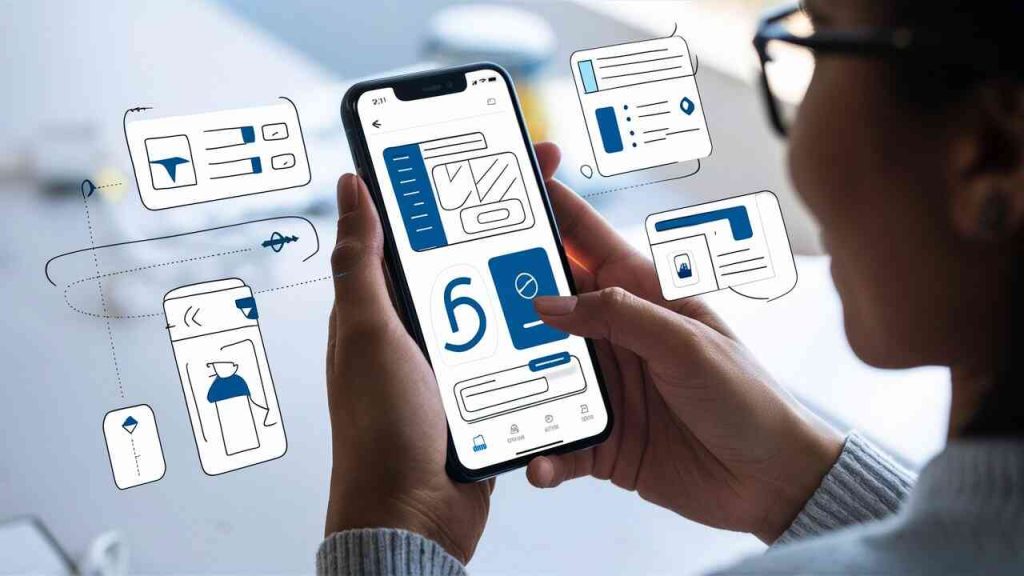Discover the 15 critical reasons why you might be missing out on 2024’s Mobile App development trends and stay ahead in the fast-evolving mobile technology landscape.

Ever feel like you’re always behind on mobile app trends?
You’re not alone.
Staying updated is tough in this fast-paced industry.
But worry not!
We’ve gathered the top 15 trends of 2024 you can’t miss.
Let’s dive into the future of mobile apps together.
Get ready for game-changing insights!
Introduction to 2024 Mobile App Development Trends
As the mobile app industry continues to evolve rapidly, developers must stay ahead of emerging trends to remain competitive. For 2024, several key trends are anticipated to shape the landscape of mobile app development. Firstly, Artificial Intelligence (AI) and Machine Learning (ML) integration will significantly influence app functionalities. AI-driven recommendation systems, chatbots, and personalization features will become increasingly prevalent.
5G Technology will further revolutionize app performance and capabilities. With faster data speeds and lower latency, 5G will enable more seamless experiences, particularly for gaming and video streaming applications. In addition, Augmented Reality (AR) and Virtual Reality (VR) applications are projected to see wider adoption as hardware and software improvements make these technologies more accessible to mainstream users.
Cross-platform development is another crucial trend. Frameworks like Flutter and React Native will continue to gain traction, allowing developers to build apps that perform efficiently on both iOS and Android platforms, thus reducing time and resource investment. The concept of low-code and no-code development will also emerge strongly, empowering more non-technical users to participate in app creation and enhancing rapid prototyping and development cycles.
Security is paramount in the digital age, and Privacy-first app development will be a key focus area. Enhanced encryption, user consent for data collection, and compliance with regulations like GDPR will be integral to gaining user trust. Alongside this, Blockchain technology is expected to play a significant role in ensuring secure transactions and data integrity within apps.
Finally, the Internet of Things (IoT) integration will continue to grow, making smart devices more interconnected and facilitating more sophisticated app functionalities. Mobile apps will increasingly serve as control hubs for a variety of IoT devices, from home automation systems to wearable health monitors.
By understanding and leveraging these trends, developers can create innovative, user-centric applications that meet the demands of an ever-evolving digital landscape. Keeping abreast of these advancements will be essential to remain relevant and competitive in the bustling mobile app market of 2024.
Failure to Monitor Emerging Technologies
Ignoring emerging technologies often leads to significant setbacks in mobile app development. With rapid technological advancements, staying informed is essential for maintaining competitiveness in the market. Failing to monitor these innovations can result in outdated applications that fail to meet user expectations and market demands.
- Dated User Interfaces: New technologies often bring fresh design trends and user interface innovations. Without adopting these trends, applications can seem old-fashioned, diminishing user engagement.
- Security Risks: Emerging technologies frequently offer advanced security features. Neglecting these can expose applications to vulnerabilities and potential breaches.
- Reduced Functionality: Leveraging new tools and frameworks can significantly enhance app functionality. Failure to integrate these advancements means missing out on features that could improve user experience and app performance.
- Decreased Efficiency: New technologies can streamline development processes through better tools and methodologies. Adhering to outdated practices can slow down development cycles, making it harder to meet tight deadlines and launch schedules.
Developers must explore:
- Artificial Intelligence and Machine Learning: Leveraging AI and ML can personalize user experiences, optimize workflows, and provide predictive analytics that influence app development strategies.
- Blockchain Technology: Incorporating blockchain can enhance app security, particularly for applications dealing with financial transactions, data integrity, and transparent record-keeping.
- 5G Integration: Preparing apps to take advantage of 5G connectivity can offer faster speeds and lower latency, which enhances user experience significantly.
- Augmented Reality (AR) and Virtual Reality (VR): Integrating AR and VR can expand an app’s functionality, providing immersive experiences that engage users more deeply.
By neglecting these advancements, developers risk falling behind competitors who embrace and capitalize on new trends. Being proactive, subscribing to industry publications, participating in developer forums, and attending tech conferences can help keep developers informed. Monitoring emerging technologies is not just a best practice; it is a necessity in the fast-paced world of mobile app development.

Neglecting User Experience (UX) Innovations
In 2024, mobile applications must prioritize advanced User Experience (UX) innovations to stay competitive. Developers who disregard evolving UX trends risk losing user engagement and market share. Key areas overlooked often include:
- Intuitive Design
- Users expect mobile apps with seamless, intuitive navigation.
- Overcomplication in design can frustrate users, leading to high abandonment rates.
- Personalization
- Modern users favor personalized content and experiences.
- Lack of customization options can make an app feel impersonal and generic.
- Microinteractions
- Small, engaging moments in the user interface enhance the overall experience.
- Missing out on microinteractions can result in a flat, uninspiring app journey.
- Accessibility
- Ensuring the app is accessible to users with disabilities widens the potential user base.
- Neglecting accessibility can alienate a significant portion of potential customers.
- Feedback Mechanisms
- Real-time feedback loops help users understand app functionalities better.
- Absence of effective feedback mechanisms can leave users confused or frustrated.
- Speed and Performance
- Users expect fast-loading apps with minimal delays.
- Poor performance and slow load times can drive users away.
Developers must incorporate these UX elements to maintain relevancy in a rapidly evolving market. Ignoring UX innovations not only diminishes user satisfaction but also undermines brand reputation. As technology and user expectations advance, staying updated with UX trends is imperative for mobile app success.
Overlooking Advanced AI and Machine Learning Integration
In the rapidly evolving landscape of mobile app development, the integration of advanced AI and machine learning has emerged as a critical factor for success. However, many developers and businesses still underestimate their significance. The oversight of AI and machine learning can lead to missed opportunities and competitive disadvantages.
Personalized User Experiences
- Dynamic Content: Apps leveraging AI can deliver personalized content, enhancing user engagement by adapting to individual preferences.
- Predictive Analysis: Machine learning algorithms can predict user behavior, improving app functionality and user satisfaction.
Automation and Efficiency
- Task Automation: AI can automate routine tasks such as personalized notifications and in-app recommendations, which can significantly enhance the user experience.
- Operational Efficiency: Integrating machine learning can streamline operations by providing actionable insights and automating customer support with chatbots.
Enhanced Security
- Anomaly Detection: AI strengthens security protocols by detecting unusual behavior which can indicate fraudulent activities.
- Biometric Authentication: AI-powered biometric verification adds an additional layer of security through facial recognition, voice recognition, and fingerprint scanning.
Improved Data Analytics
- Real-Time Analytics: Machine learning models analyze vast amounts of data in real-time, assisting developers in making informed decisions and improving app performance.
- Customer Insights: By evaluating user interactions, AI provides deep insights into customer preferences, aiding in the development of more effective marketing strategies.
Adaptive and Scalable Solutions
- Scalability: AI can adapt applications to handle an increasing number of users efficiently without compromising performance.
- Adaptive Learning: Machine learning models within apps can adapt to new data inputs, ensuring apps remain relevant and functional over time.
Competitive Edge
Ignoring AI and machine learning trends can result in a competitive disadvantage. Staying updated with the latest advancements and integrating them effectively is crucial for maintaining relevance and superiority in the market.
Resource Utilization
- Efficient Use of Data: AI uses data more efficiently by identifying patterns and optimizing resource allocation.
- Cost Reduction: Leveraging AI can reduce operational costs by minimizing the need for human intervention in automated processes.
Note: Overlooking the integration of advanced AI and machine learning capabilities in mobile app development can significantly hamper innovation and growth prospects in 2024.
A more proactive approach to adopting these technologies is essential for staying ahead in the competitive mobile apps market.
Not Adopting Progressive Web Apps (PWAs)
Progressive Web Apps (PWAs) leverage modern web capabilities to deliver an app-like user experience directly through the browser. By not adopting PWAs in mobile app development, organizations miss out on several significant advantages:
- Improved Performance
- PWAs load quicker by utilizing service workers to cache assets, ensuring faster performance and smooth user experiences even with slow internet connections.
- Reduced Development Costs
- Developing PWAs avoids the need to build separate native applications for iOS and Android, significantly reducing development and maintenance costs.
- Enhanced User Engagement
- PWAs offer features like push notifications, similar to native apps, which improve user engagement.
- Seamless Updates
- Service workers facilitate instant updates without requiring users to download new versions from app stores.
- Broader Audience Reach
- As PWAs work on any browser, they can target a wider audience, including those who might not be willing to download a native app.
- Offline Access
- Once assets are cached, PWAs can function offline, providing uninterrupted access to users.
“PWAs can reduce bounce rates by over 50% by ensuring quick access to content and services.”
Some of the critical features that are missed when neglecting PWAs include:
- Responsive Design:
- Designed to work on any device and screen size, delivering a consistent user experience across different devices.
- App-like Feel:
- Utilizes app shell architecture to deliver a smoother, more immersive user experience that mimics native applications.
- SEO Benefits:
- PWAs are indexed by search engines, improving visibility and driving more traffic than native applications that remain confined to app stores.
- Hardware Access:
- Cutting-edge APIs allow PWAs to access device features like the camera, GPS, and others, bridging the gap between web and native capabilities.
Failing to integrate PWAs into the development roadmap in 2024 means missing out on these crucial benefits, potentially ceding competitive advantage and customer satisfaction to companies that have adapted to this trend. For businesses aiming to stay at the forefront of mobile app trends, embracing PWAs is not just a recommendation but a necessity.
Ignoring Cross-Platform Development Tools
Developers failing to adopt cross-platform development tools in 2024 are missing significant mobile app trends. These tools, such as Flutter, React Native, and Xamarin, offer numerous advantages.
- Reduced Development Time: Cross-platform tools allow developers to write code once and deploy it across multiple platforms, significantly cutting down development time.
- Cost-Effectiveness: Developing a single codebase for both iOS and Android reduces the cost, making it an attractive option for startups and small businesses.
- Consistent User Experience: Cross-platform tools ensure a uniform look and feel across different devices, enhancing user satisfaction.
- Single Team Requirements: Teams can consist of developers skilled in one technology stack rather than needing separate expertise in iOS and Android.
- Faster Go-To-Market: Leveraging these tools enables quicker updates and feature implementation, providing a competitive advantage.
- Access to a Wide Range of Plugins: Many cross-platform tools come with libraries and plugins that streamline integration with third-party services, such as payment gateways and social media platforms.
Technological Advancements
Ignoring advancements in cross-platform development means missing cutting-edge features. Modern tools frequently update to incorporate new technological trends, such as AI and augmented reality. They also adapt to new hardware capabilities in smartphones, ensuring apps remain functional and competitive.
Scalability Concerns
Cross-platform development tools are increasingly scalable, allowing apps to grow and adapt without significant rewrites. Skipping these tools can lead to issues in scaling, requiring more extensive maintenance and potentially leading to outdated apps.
Case Studies
Case Study 1: A fintech company reduced its time to market by 50% using Flutter for its mobile app, enabling quicker adoption and feedback loop.
Case Study 2: An e-commerce startup saved over 30% in development costs by employing React Native, facilitating rapid feature deployment across iOS and Android platforms.
Industry Trends
Major companies, including Alibaba and Airbnb, are capitalizing on cross-platform tools, showing a clear industry trend. Ignoring these tools means missing out on the benefits reaped by competitors who are adopting this approach.
By neglecting cross-platform development tools, developers fail to utilize advancements that streamline the development process, save costs, and deliver apps faster while ensuring consistent user experiences.
Missing Out on Enhanced Security Features
2024 mobile app development trends emphasize robust security measures more than ever. The technological landscape continually evolves, presenting new vulnerabilities. Failing to keep pace with security innovations leaves applications susceptible to breaches and other malicious activities.
Developers not upgrading security protocols may miss out on:
- End-to-End Encryption:
- More applications integrate end-to-end encryption to protect sensitive user data during transmission. This method ensures data remains encrypted from sender to recipient, inaccessible to potential interceptors.
- Biometric Authentication:
- Advanced biometric options such as facial recognition and voice recognition provide enhanced security. Apps leveraging these methods offer users a seamless, yet secure, login experience.
- AI-Powered Threat Detection:
- Artificial intelligence plays a significant role in identifying and mitigating potential threats. AI-driven algorithms proactively detect unusual activity patterns, flagging potential breaches before they happen.
- Multi-Factor Authentication (MFA):
- MFA is becoming standard practice, requiring users to present multiple verification methods to gain access. This heightened layer of security makes unauthorized access significantly more difficult.
- Secure Development Practices:
- Secure coding practices and regular security audits ensure vulnerabilities are identified and addressed during the development phase. Implementing these practices prevent potential exploits post-launch.
- Regular Security Updates:
- Continuous monitoring and timely updates are crucial. Frequent updates address known vulnerabilities, making it harder for hackers to exploit weaknesses.
Overlooking these advancements can have severe implications:
According to a report by Cybersecurity Ventures, cybercrime damages are expected to reach $10.5 trillion annually by 2025. This substantial risk underscores the importance of incorporating cutting-edge security measures in app development.
Firms should prioritize the following to stay ahead:
- Conduct regular security training for developers.
- Implement a robust incident response plan.
- Collaborate with cybersecurity experts to continuously refine security policies.
In summary, keeping up with enhanced security features is not just an option but a necessity for mobile app developers. Failing to do so compromises user trust and app integrity, with potentially disastrous consequences.

Underestimating 5G Capabilities in Mobile Apps
The emergence of 5G networks has brought transformative potential to mobile app development, yet many developers continue to undervalue its capabilities.
Speed and Efficiency
5G networks offer unprecedented speeds, drastically reducing latency and improving the efficiency of mobile apps. Developers can now:
- Implement real-time functionalities seamlessly.
- Enhance user experiences with faster load times.
- Support high-definition video and augmented reality without buffering issues.
Enhanced Connectivity
5G provides enhanced connectivity with its ability to support a massive number of devices concurrently. This feature is pivotal for:
- IoT applications requiring robust, real-time connectivity.
- Multi-device interactions within smart ecosystems.
- High-demand applications like live streaming and online gaming.
Expanded Features
With 5G’s capacity, app developers can explore new features previously deemed impractical:
- Augmented Reality (AR) and Virtual Reality (VR): Innovate immersive experiences with reduced latency.
- Edge Computing: Distribute data processing closer to data sources, improving response times.
- Advanced AI and Machine Learning: Deploy sophisticated AI models directly on devices for real-time decision-making.
Business Opportunities
Businesses leveraging 5G stand to gain significant competitive advantages:
- Enhanced Customer Engagement: Apps can offer personalized, interactive experiences.
- New Revenue Streams: Innovations like AR advertising and in-app purchases driven by seamless user interaction.
- Increased Operational Efficiency: Real-time data analytics and reporting facilitated by high-speed connectivity.
Security and Reliability
Given the increased bandwidth and connection stability of 5G, developers must:
- Integrate advanced security measures to handle larger data volumes.
- Ensure app reliability to maintain seamless service in high-demand scenarios.
Adoption Challenges
Despite these advantages, several challenges impede the full embrace of 5G:
- Infrastructural Limitations: Regions without 5G coverage remain reliant on 4G.
- Device Compatibility: Not all users have 5G-capable devices.
- High Development Costs: Leveraging 5G capabilities may require significant investment.
Developers and businesses must proactively address these factors to harness the full potential of 5G in mobile apps, paving the way for innovative, highly responsive applications in the evolving digital landscape.

Lack of Focus on AR and VR Implementations
One significant reason organizations may miss 2024 mobile app development trends is a lack of focus on Augmented Reality (AR) and Virtual Reality (VR) implementations. Despite the upward trajectory of AR and VR technologies, many developers still show reluctance to integrate these into their mobile apps. This hesitation can be attributed to various factors that need addressing for forward-looking advancements in app development.
- Complexity in Development:
- AR and VR require specialized knowledge, which increases the complexity of the development process.
- Developers may need additional training in 3D modeling, spatial audio, and user interaction design specific to AR and VR.
- High Development Costs:
- The incorporation of AR and VR can necessitate significant financial investment.
- Costs associated with acquiring or developing the right hardware, such as AR glasses or VR headsets, can be prohibitive.
- Lack of Consumer Readiness:
- User base for AR and VR technologies is still relatively niche.
- Many potential users may not yet own AR/VR-compatible devices, leading to concerns over market reach.
- Limited Understanding of Potential Applications:
- Many organizations have not fully explored how AR and VR can be integrated into their business models.
- A narrow focus on traditional app functionalities can limit innovative uses of these technologies.
- Resource Constraints:
- Smaller development teams may lack the resources to experiment with AR and VR due to limited manpower and time.
- Prioritizing basic features over advanced functionalities often leads to not exploring AR and VR.
- Technological Barriers:
- Latency and performance issues continue to be problems in AR/VR development.
- Ensuring seamless integration with existing technology stacks can be a significant hurdle.
“Early adopters of AR and VR are setting themselves apart by providing richer, more immersive user experiences.”
- User Experience Challenges:
- Piloting AR and VR features may lead to inconsistent user experiences if not perfectly executed.
- Poor executions can deter users rather than engaging them, emphasizing the need for seamless implementation.
- Regulatory and Privacy Concerns:
- AR and VR applications raise new questions around user privacy, data security, and appropriate use.
- Navigating these regulatory landscapes can be daunting, leading some to avoid engaging in AR and VR initiatives altogether.
Without an intentional effort to understand and integrate AR and VR into mobile applications, developers risk falling behind on not just current trends, but also the future trajectory of mobile technologies. Strategic planning and allocation of resources toward these advanced technologies are essential to staying ahead in the competitive mobile app landscape.

Failure to Embrace Blockchain Technology
Blockchain technology offers enhanced security, transparency, and efficiency for mobile applications, yet many developers have been slow to adopt it. This hesitation puts them at a significant disadvantage in the rapidly evolving landscape of mobile app development.
Security Enhancements
- Data Integrity: Blockchain ensures data cannot be tampered with, providing robust protection against fraud.
- Decentralization: By eliminating a central point of failure, it significantly reduces the risk of data breaches.
- User Control: Users can own and manage their data, leading to increased trust and adoption.
Transparency and Trust
- Immutable Records: Each transaction recorded on a blockchain is immutable and verifiable, fostering user trust.
- Smart Contracts: Automated execution of smart contracts ensures transparent and reliable business processes within the app.
Efficiency Gains
- Resource Optimization: Decentralized ledgers can streamline transactions and reduce the cost and time associated with verification processes.
- Simplified Auditing: The transparent nature of blockchain facilitates easier and more efficient audits.
Missed Opportunities
- Enhanced Transactions: Integrating blockchain allows for safe and transparent in-app purchases and transactions.
- Future-Proofing: Early adoption of blockchain lays the groundwork for advanced technologies such as Web 3.0.
- Competitive Edge: Proficiency in blockchain positions developers ahead of those lagging in adoption, offering unique selling points for their applications.
Resistance Factors
Developers are often wary due to the perceived complexity and resource intensity of blockchain. However, modern blockchain platforms and development tools are becoming more accessible.
Real-World Applications
- Financial Services: Mobile wallets, peer-to-peer payments, and decentralized finance (DeFi) apps.
- Supply Chain Management: Apps that track products from origin to destination, ensuring authenticity and reducing fraud.
- Healthcare: Secure handling of patient records, preserving privacy while ensuring accuracy and accessibility.
Conclusion
Failing to incorporate blockchain technology can result in lagging behind competitors. Developers must educate themselves on its benefits and applications to stay relevant in the mobile app development landscape. Blockchain isn’t just an option; it’s becoming a necessity for securing a future in this rapidly advancing industry.
Neglecting the Impact of IoT on Mobile Apps
In the ever-evolving landscape of mobile app development, the Internet of Things (IoT) represents a significant paradigm shift that cannot be overlooked. Despite its transformative potential, many developers fail to incorporate IoT functionalities adequately, thereby missing out on substantial opportunities for innovation and user engagement.
Key implications of neglecting IoT include:
- Missed Opportunities for Enhanced Functionality:
- IoT-enabled apps can integrate seamlessly with a multitude of devices, offering users a cohesive, interconnected experience.
- Failing to leverage IoT means depriving users of real-time data exchange and automation capabilities that elevate user convenience.
- Competitive Disadvantage:
- Competitors who embrace IoT are equipped to deliver superior, multifaceted solutions.
- Staying behind in IoT adoption places apps at a notable disadvantage, losing users to more technologically advanced alternatives.
- Security Vulnerabilities:
- The lack of IoT integration often results in fragmented data management practices.
- An integrated IoT ecosystem enhances security protocols through comprehensive, cross-device encryption and monitoring systems.
- User Experience Deficiencies:
- Modern users favor intelligent apps that anticipate and respond to their needs automatically.
- Neglecting IoT features may lead to a subpar user experience, affecting user retention and satisfaction.
Consider the following strategies to counter IoT negligence:
- Adoption of Hybrid App Models:
- Hybrid apps facilitate seamless integration with various IoT platforms, ensuring compatibility and robust performance.
- Advanced Data Analytics:
- Utilize machine learning and AI to harvest actionable insights from IoT data, enhancing app functionality and user engagement.
- Focus on Interoperability:
- Ensure that your applications can communicate effectively with a wide range of IoT devices.
- Continuous Updates and Security Patches:
- Regular updates are critical to protect against emerging threats and to maintain the integrity of IoT communication channels.
By overlooking IoT, developers risk creating outdated, less functional applications that fail to meet modern expectations. Integrating IoT not only future-proofs mobile apps but also unlocks new dimensions of user interactivity and service efficiency.
Not Leveraging Cloud Computing Benefits
Cloud computing has become indispensable in mobile app development, offering flexibility, scalability, and cost-efficiency. However, many developers still fail to harness the full potential of cloud computing.
Key Benefits Often Overlooked
- Scalability:
- Cloud platforms offer scalable resources. Applications can easily scale up or down based on demand, ensuring optimal performance during peak usage periods without over-investing in infrastructure.
- Cost Efficiency:
- Traditional servers require hefty initial investments and ongoing maintenance costs. Cloud services operate on a pay-as-you-go model, allowing developers to manage budgets more effectively by only paying for what they use.
- Global Accessibility:
- Cloud computing ensures that applications and data are accessible from anywhere in the world. This global reach is critical for providing seamless user experiences for international users.
- Data Synchronization:
- With cloud computing, data synchronization across various devices becomes more straightforward, enhancing user experiences by allowing real-time updates and consistency across platforms.
Common Pitfalls
- Security Concerns:
- While cloud services offer robust security measures, developers often fail to implement additional layers of security necessary for sensitive data, leading to potential vulnerabilities and compliance issues.
- Performance Issues:
- Not optimizing cloud resources can lead to performance bottlenecks. Developers must monitor and adjust resource allocation to maintain optimal performance.
- Integration Challenges:
- Integrating cloud services with existing systems can be complex. Poor integration can lead to data inconsistencies and operational disruptions.
Strategic Approach
- Adopt Multi-Cloud Strategies:
- Using multiple cloud providers can mitigate risks of downtime and provide better redundancy and reliability.
- Invest in Cloud Training:
- Regular training and updates on the latest cloud technologies can equip development teams with the knowledge to fully exploit cloud capabilities.
- Implement Robust Security Measures:
- Employ advanced encryption, multi-factor authentication, and regular security audits to safeguard data integrity and privacy.
Case Studies
- Netflix:
- Leveraged cloud computing for scalability to stream video content efficiently to millions of global users.
- Airbnb:
- Used cloud services to manage their extensive database of properties and user interactions seamlessly, offering consistent performance and uptime.
Conclusion
Neglecting cloud computing’s capabilities can severely impact an application’s efficiency and scalability. Addressing the above aspects can enable developers to stay ahead in the competitive landscape and align with 2024 mobile app development trends.
Overlooking the Importance of App Store Optimization (ASO)
App Store Optimization (ASO) is often neglected in the development process, leading to poor app visibility and download rates. Many developers underplay ASO, which covers the strategies and techniques to enhance app ranking in app store search results.
Key Components of ASO
- Keyword Optimization: Selecting the right keywords is crucial for improving search visibility. Keywords should be relevant to the app’s core functionality and user search behavior.
- Compelling App Title and Description: The app title and description should be engaging and informative. Including relevant keywords naturally increases the chances of being found by prospective users.
- High-Quality Visuals: Screenshots, videos, and the app icon significantly impact user acquisition. They should accurately depict the app’s functionality and appeal to the target audience.
- Positive User Reviews and Ratings: High ratings and positive reviews enhance credibility and encourage downloads. Developers should encourage satisfied users to leave positive feedback.
Common Pitfalls
- Ignoring Keyword Trends: Many developers fail to research and integrate trending keywords, which can drastically reduce app discoverability.
- Weak Visual Representation: Poor-quality visuals or outdated design elements can turn potential users away, affecting download rates adversarially.
- Neglecting User Feedback: Ignoring negative reviews or failing to respond to user concerns can damage an app’s reputation and lower its ranking.
Improvement Strategies
- Regular Updates: Continuously updating the app store listing, including visuals and descriptions, helps in keeping the app relevant and engaging.
- A/B Testing: Conducting A/B testing on different elements of the store listing such as icons, screenshots, and descriptions can determine the most effective versions.
- Performance Monitoring: Regularly monitoring the app’s performance metrics in the app store helps in identifying areas for improvement and enables timely interventions.
Ignoring ASO can severely hamper an app’s potential to reach its intended audience. Developers need to prioritize ASO to stand out amidst the millions of apps available across various app stores. Properly executed ASO contributes significantly to an app’s success, offering a substantial competitive edge.
Inadequate Attention to Personalized User Engagement
Ignoring the necessity of personalized user engagement could hold back a mobile app’s potential. Today’s user expects an experience tailored uniquely to their needs and preferences. When apps fail to deliver personalized interactions, user engagement drops significantly.
Key Aspects of Personalization:
- User Data Analysis: Effective use of analytics to understand user behavior patterns is crucial. It helps in identifying what users prefer, when they prefer it, and how they interact with different app features.
- Customized Content Delivery: Providing content that resonates with individual user preferences is essential. This can include personalized recommendations based on previous interactions, tailored notifications, and relevant content feeds.
- Adaptive User Interfaces: Developing adaptable interfaces that respond to user behavior improves overall user experience. Dynamic UI elements that adjust based on user interactions make an app feel more intuitive and user-friendly.
Common Shortfalls in Personalization:
- Generic User Experience: Many apps still deploy one-size-fits-all interfaces and content strategies. This approach often leads users to feel disengaged and undervalued.
- Insufficient User Insights: Failing to collect and accurately analyze user data results in a lack of actionable insights. Without these, it’s challenging to implement effective personalization strategies.
- Over-Personalization Risks: While personalization is key, overdoing it can lead to privacy concerns and user discomfort. Striking a balance is critical to avoid seeming invasive.
Tools and Strategies for Better Personalization:
- Machine Learning Algorithms: Utilizing machine learning can significantly enhance personalization by predicting user preferences and behaviours more accurately.
- A/B Testing: This helps determine what personalized elements resonate best with different user segments, aiding in more effective customization.
- Feedback Loops: Integrating user feedback mechanisms ensures that personalization efforts are aligned with actual user expectations and needs.
Inadequate attention to personalized user engagement stands as a significant barrier to securing a competitive edge in the mobile app market. By prioritizing and refining personalization strategies, applications can foster deeper user connections and drive sustained engagement.
Conclusion: Staying Ahead in Mobile App Development Trends
Staying ahead in mobile app development requires more than just technical proficiency; it involves understanding market shifts, technological advancements, and user expectations. Development teams need to continuously refine their strategies to align with evolving trends and industry standards.
Key Areas to Focus On:
- User Experience (UX) Design:
- Ensure intuitive navigation.
- Prioritize accessibility and inclusivity.
- Artificial Intelligence and Machine Learning:
- Integrate AI for personalized user interactions.
- Utilize ML for predictive analytics.
- Cross-Platform Development:
- Leverage frameworks like Flutter and React Native.
- Maintain consistency across various devices.
- Security Enhancements:
- Implement advanced encryption techniques.
- Regularly update to mitigate vulnerabilities.
- Augmented Reality (AR) and Virtual Reality (VR):
- Enhance user engagement through immersive experiences.
- Explore AR for retail and education sectors.
Strategies for Staying Updated:
- Continuous Learning:
- Attend industry conferences and webinars.
- Participate in workshops and training sessions.
- Research and Development (R&D):
- Invest in R&D to explore innovative solutions.
- Collaborate with tech startups for fresh perspectives.
- User Feedback:
- Actively collect and analyze user feedback.
- Implement iterative improvements based on user insights.
Important Reminders:
Embrace a proactive approach to innovation. Monitor emerging technologies and market trends regularly. Adaptability is key to maintaining a competitive edge.
- Networking:
- Join professional networks and forums.
- Engage with thought leaders and industry experts.
- Tools and Technologies:
- Utilize the latest development tools.
- Monitor updates and new releases in development platforms.
Industry Best Practices:
- Agile Methodologies:
- Adopt agile frameworks for project management.
- Encourage collaborative workflows.
- Performance Optimization:
- Focus on app speed and reliability.
- Regularly review and optimize code.
- Future-Proofing:
- Plan for scalability and future updates.
- Keep abreast of hardware advancements.
Network extensively, continually invest in R&D, harness user feedback effectively, and adopt industry best practices to remain at the forefront of the constantly evolving mobile app development landscape.
For Services: contact Xelent.pk

